沪教牛津版 七年级英语下 教案
- 格式:doc
- 大小:81.50 KB
- 文档页数:7
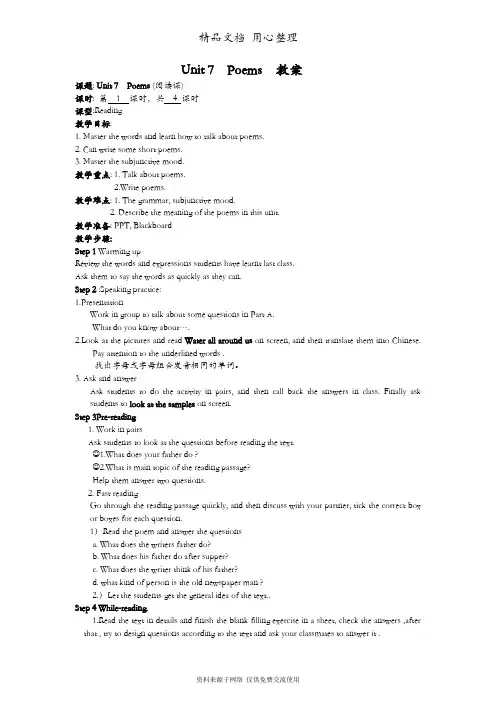
Unit 7 Poems 教案课题: Unit 7 Poems (阅读课)课时: 第 1 课时,共 4 课时课型:Reading教学目标:1. Master the words and learn how to talk about poems.2. Can write some short poems.3. Master the subjunctive mood.教学重点: 1. Talk about poems.2.Write poems.教学难点: 1. The grammar, subjunctive mood.2. Describe the meaning of the poems in this unit.教学准备: PPT, Blackboard教学步骤:Step 1 Warming upReview the words and expressions students have learnt last class.Ask them to say the words as quickly as they can.Step 2 :Speaking practice:1.PresentationWork in group to talk about some questions in Part A.What do you know about….2.Look at the pictures and read Water all around us on screen, and then translate them into Chinese.Pay attention to the underlined words .找出字母或字母组合发音相同的单词。
3. Ask and answerAsk students to do the activity in pairs, and then call back the answers in class. Finally ask students to look at the samples on screen.Step 3Pre-reading1. Work in pairsAsk students to look at the questions before reading the text.☺1.What does your father do ?☺2.What is main topic of the reading passage?Help them answer two questions.2. Fast readingGo through the reading passage quickly, and then discuss with your partner, tick the correct box or boxes for each question.1)Read the poem and answer the questionsa. What does the writers father do?b. What does his father do after supper?c. What does the writer think of his father?d. what kind of person is the old newspaper man ?2.)Let the students get the general idea of the text..Step 4 While-reading.1.Read the text in details and finish the blank filling exercise in a sheet, check the answers ,after that , try to design questions according to the text and ask your classmates to answer it .2.Hand out the sheet and design the blank according to the important information. Then check the answers with studentsStep 5 Post reading1. Read the sentences and choose true or false.2. Look at the screen and fill in the blanks.3. Summary the five kinds poems in the unit.Step 6 Learning about language1. Read and recite the words about poems2. Learn the words and phrases in the passage.Step7 Exercise1.Finish the exercise in Part C and D.2.Help them to find the details in the text.Step 8 Sum upStep9Homework1. Read the text fluently2 write a passage to introduce a kind of person who impress you mostStep10 The blackboard designUnit 7 Poemsworried about something 担心某事rush out 奔跑,冲a crowd of 一大堆too…to….太…而不能…see sb doing sth 看见某人正在做某事课题: Unit 7 Poems (听说课)课时: 第 2 课时,共 4 课时课型: Listening & Speaking教学目标:1.listen to poem and learn to read a poem in a better way2. improve their listening and speaking skills3. Students listening ability is improved.教学重点:Get the main points of the listening.教学难点:The new words in the listening.教学准备: PPT, Blackboard, music教学步骤:Step 1 Leading in1. Pre-listeningShow some feelings for students to guess the meaning of some words.2. Opening discussionStep 2 Prepare for the listening and speaking1.Prepare for the listening , read the words and match the expressions in Part A2.Check the answers in Part AStep 3 Do the listening1. Do the listening and fill in the blank of the chart in Part A and B.2. Play the listening materials , stop when necessary and then check the answersStep 4 Speaking (Word stress)1.什么事动词重音?2.让学生尝试读出A1部分中的双音节词,注意重音的读法及位置,重音在第一个音节上。
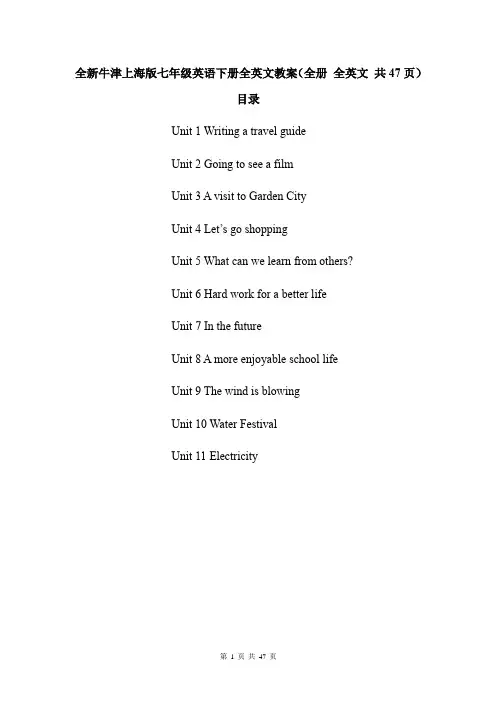
全新牛津上海版七年级英语下册全英文教案(全册全英文共47页)目录Unit 1 Writing a travel guideUnit 2 Going to see a filmUnit 3 A visit to Garden CityUnit 4 Let’s go shoppingUnit 5 What can we learn from others?Unit 6 Hard work for a better lifeUnit 7 In the futureUnit 8 A more enjoyable school lifeUnit 9 The wind is blowingUnit 10 Water FestivalUnit 11 ElectricityUnit 1 Writing a travel guide1教学目标By the end of the lesson, the Sts will…be able to further practise describing a place and know more about Shanghai.be able to develop their speaking ability of fluency by describing a scenic spot.2学情分析The learners are the students form Class Twelve, Grade Seven of North Jincai Secondary School. They have been learning English for 7 years, so they are of different levels. Quit e a few students are quite excellent. They do well in both speaking and writing. They are very active in class. But some students are at a lower English level. However, sometime s they can speak a little in class. What they need is a language environment. Therefore, g roup work in class is helpful for them to take an active part in the class.3重点难点This is ‘more practice’ part of Module One. The topic is A One-day Tour Plan. We have talked about some famous places in the previous period, so the students have learned so me expressions. There will be a language environment created for them so as to encourag e more of them to talk about scenic spots and their tour plans.Key phrases and sentence structures are familiar to students. But it will be a little hard fo r them to organize language with much new information. So teacher can take fully advant age of group work. The students may have difficulty in listening to the French in the sec ond part because of the accent. Teachers can give students a second chance to listen.Some students may also have difficulty in pronouncing some words. Teachers can guide them t o use the dictionaries on their Pads.4教学过程第一学时教学目标By the end of the lesson, the S ts will…be able to further practise describing a place and know more about Shanghai.be able to develop their speaking ability of fluency by describing a scenic spot.学时重点This is ‘more practice’ part of Module One. The topic is A One-day Tour Plan. We have talked about some famous places in the previous period, so the students have learned so me expressions. There will be a language environment created for them so as to encourag e more of them to talk about scenic spots and their tour plans.学时难点Key phrases and sentence structures are familiar to students. But it will be a little hard fo r them to organize language with much new information. So teacher can take fully advant age of group work. The students may have difficulty in listening to the French in the sec ond part because of the accent. Teachers can give students a second chance to listen.Some students may also have difficulty in pronouncing some words. Teachers can guide them t o use the dictionaries on their Pads.教学活动活动1【导入】Lead inIt’s said that th ey really enjoyed the trip to Shanghai. Do you want to know where they have been? I will show you some pictures of places they’ve been. Please take notes when you are watching.T gives the following instructions:1. I will show you some pictures of places they’ve been.2. Please take notes when you are watching.3. After that, please tell me how many places are there altogether and what they are.T shows four pictures of some places.S answers according to the picture.T corrects the mistakes and may show the pictures again if necessary.(Pudong International Airport, the bund, Yu garden, Shanghai zoo, Xintiandi, Shanghai Sci ence and Technology Museum and Shanghai Museum)活动2【活动】Input-listeningT: Among these pictures, do you know their favourite place?Students may give some answers or no answer.T: I’ve invited 4 French students to talk about their favourite places. Let’s listen to them. Please take notes while listening.T plays the recording one by one.T invites students to give answers and give reasons.T gives feedback if the students’ answers are wrong.活动3【活动】Input-readingT: French students told me that they wanted to know more about Shanghai, about those t hey have been to, and also about those they haven’t. Would you please give them some i ntroductions about more places? First, you need to read some instructions.T gives the instructions.1. Work in a group of 6.2. Each group needs to read 8 passages and find useful information as much as possible.3. Take notes and finish the table.4. Group A is responsible for sightseeing, Group B shopping and Group C eating.T provides individual drilling.活动4【活动】Output-an introduction about a scenic spotT invites some students to introduce some scenic spots according to the information they have taken down.T gives feedbacks about their presentations.活动5【活动】Output-a tour planT: I think they will enjoy those places. So why not make a tour plan for them? Please d iscuss with your group members and make a one-day tour plan for them. Each group nee ds to focus on your task. (Group A sightseeing Group B eating Group C shopping.)T provides individual drilling.T invites some students to give presentations about their tour plans.T gives feedbacks about their presentations.活动6【作业】AssignmentT: Write down your 3-day tour plan for French students. The school may use your plan next year.e.g.: On the first day, they are going to …Unit 2 Going to see a film1教学目标认知目标:课标词汇hardly, type, operate, railway, fly, judge, raise, instruction, program, mistake, hold, video, more importantly, have great understanding of…, make mistakes, for the time being拓展词汇unaware, be unaware of…, dependent, be dependent on…,diagram,essential, drive, CD-ROM, DVD-ROM2. 能力发展目标:1)通过多种形式的阅读活动与任务,培养一些阅读微技能,如:整体把握文章大意,快速搜索信息的能力2)设计小组合作,学会交流与合作3)情感目标:拓展学生视野,培养学生正确表达自己观点,学会对电影做出评价2学情分析1.这是一篇影评,比较枯燥,学生容易失去兴趣。
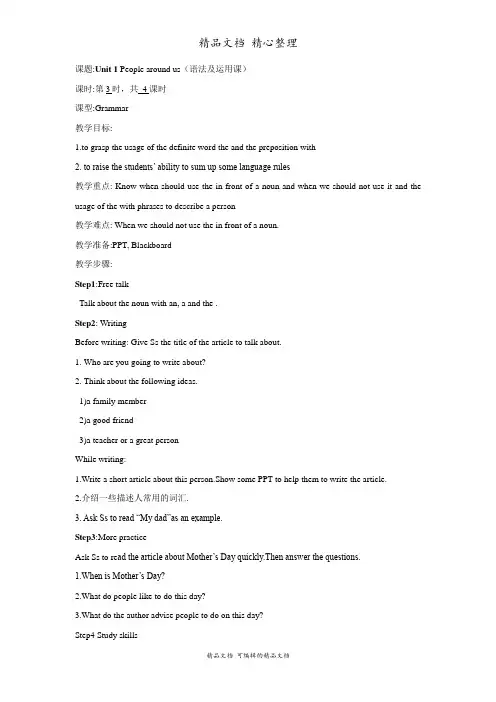
课题:Unit 1 People around us(语法及运用课)课时:第3时,共 4 课时课型:Grammar教学目标:1.to grasp the usage of the definite word the and the preposition with2. to raise the students’ ability to sum up some language rules教学重点: Know when should use the in front of a noun and when we should not use it and the usage of the with phrases to describe a person教学难点: When we should not use the in front of a noun.教学准备:PPT, Blackboard教学步骤:Step1:Free talkTalk about the noun with an, a and the .Step2: WritingBefore writing: Give Ss the title of the article to talk about.1.Who are you going to write about?2.Think about the following ideas.1)a family member2)a good friend3)a teacher or a great personWhile writing:1.Write a short article about this person.Show some PPT to help them to write the article.2.介绍一些描述人常用的词汇.3. Ask Ss to read “My dad”as an example.Step3:More practiceAsk Ss to re ad the article about Mother’s Day quickly.Then answer the questions.1.When is Mother’s Day?2.What do people like to do this day?3.What do the author advise people to do on this day?Step4 Study skills1.Learn line graphs and bar charts to show the change in numbers.2.Fill in the blanks.3.Check their answers.Step 4:Culture corner1.Introduce middle names for Ss.2.Write some famous people’s middle names.Step5:Sum up1.Go over the rules of theStep6: HomeworkStep7 The blackboard design1.冠词“a\an”的用法。
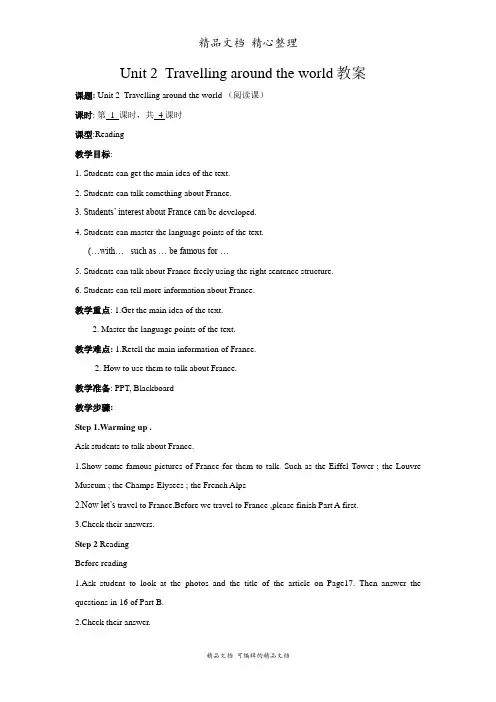
Unit 2 Travelling around the world教案课题: Unit 2 Travelling around the world (阅读课)课时: 第 1 课时,共 4 课时课型:Reading教学目标:1. Students can get the main idea of the text.2. Students can talk something about France.3. Students’ interest about France can b e developed.4. Students can master the language points of the text.(…with… such as … be famous for …5. Students can talk about France freely using the right sentence structure.6. Students can tell more information about France.教学重点: 1.Get the main idea of the text.2. Master the language points of the text.教学难点: 1.Retell the main information of France.2. How to use them to talk about France.教学准备: PPT, Blackboard教学步骤:Step 1.Warming up .Ask students to talk about France.1.Show some famous pictures of France for them to talk. Such as the Eiffel Tower ;the Louvre Museum ;the Champs-Elysees ;the French Alps2.Now let’s travel to France.Before we travel to France ,please finish Part A first.3.Check their answers.Step 2 ReadingBefore reading1.Ask student to look at the photos and the title of the article on Page17. Then answer the questions in 16 of Part B.2.Check their answer.3.Show the structure of the article for them.While reading1.Read Paragraph 1 and 2 to fill in the form. Check their answers.2. Read Paragraph 3 and 4 to answer some questions.Then check their answers.Post-readingFinish D2 after read the article.Then check their answers.Step 3 RetellingRetell the text, according to the key words(group work) .1. Practice retelling the text one by one in groups.2. Help them to review the key sentences or words and encourage them to retell the text. Step4 Reading comprehension.Read the passage and finish C1;C2;D2;D3(check the answers in groups)Step 5 Language points. Self- study.①Read the text to find the important sentences .②Learn the learning sheet to finish the related exercise .③Group work to share the learning result and help to solve the different points.④show the learning result by groups.Step 6 Using the language points.(games :lucky member)Step 7 DiscussionSolve the problems given by the teacher to earn marks for their group.Step8 Sum upSummarize the language points and group work resultStep9 HomeworkStep 10 The blackboard designbe famous for 以…闻名by the sea 在海边prefer to 更喜欢why not +动词原形=why don’t you +动词原形?为何不做某事?。
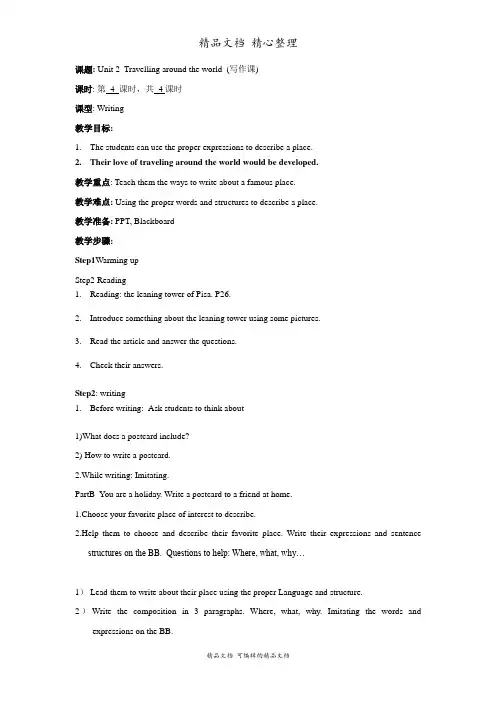
课题: Unit 2 Travelling around the world (写作课)课时: 第 4 课时,共 4 课时课型: Writing教学目标:1.The students can use the proper expressions to describe a place.2.Their love of traveling around the world would be developed.教学重点: Teach them the ways to write about a famous place.教学难点: Using the proper words and structures to describe a place.教学准备: PPT, Blackboard教学步骤:Step1Warming upStep2 Reading1.Reading: the leaning tower of Pisa. P26.2.Introduce something about the leaning tower using some pictures.3.Read the article and answer the questions.4.Check their answers.Step2: writing1.Before writing: Ask students to think about1)What does a postcard include?2) How to write a postcard.2.While writing: Imitating.PartB You are a holiday. Write a postcard to a friend at home.1.Choose your favorite place of interest to describe.2.Help them to choose and describe their favorite place. Write their expressions and sentencestructures on the BB. Questions to help: Where, what, why…1) Lead them to write about their place using the proper Language and structure.2)Write the composition in 3 paragraphs. Where, what, why. Imitating the words and expressions on the BB.3)Lead them to write about their place using the proper Language and structure.3.After writing: Check with each other.1)Teach them how to evaluate a writing.2)exchange the writing in pairs to give remarks to each other .Step3 .Culture corner—BackpackingWork in groups to talk about Backpacking.Step 4 Project1.Ask students to work in groups to finish PartA then check their answers.2.Ask each group to choose a city from A and do some reach about it.3.PartC.Ask some groups to introduce the city to the class.Step5 DevelopmentHelp them to develop their work in words, sentence and structure.Step 6HomeworkRefer to P25 to write a postcard to your friend if you are traveling in your favorite place. Step7 The blackboard designUnit 2 Travelling around the world1.明信片的构成及写法。
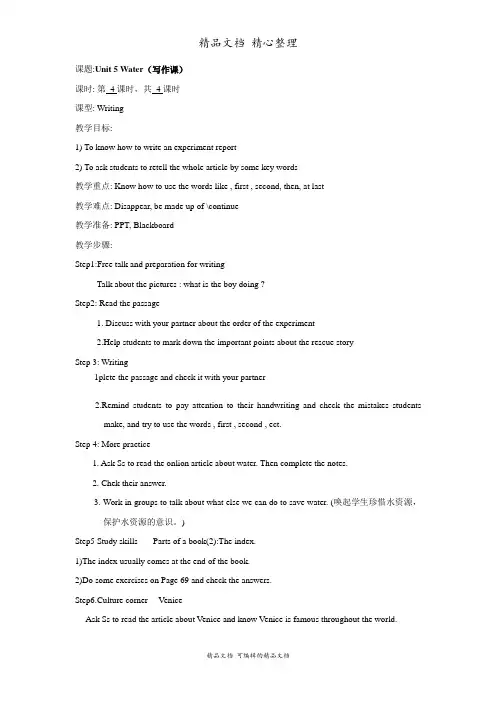
课题:Unit 5 Water(写作课)课时: 第 4 课时,共 4 课时课型: Writing教学目标:1) To know how to write an experiment report2) To ask students to retell the whole article by some key words教学重点: Know how to use the words like , first , second, then, at last教学难点: Disappear, be made up of \continue教学准备: PPT, Blackboard教学步骤:Step1:Free talk and preparation for writingTalk about the pictures : what is the boy doing ?Step2: Read the passage1. Discuss with your partner about the order of the experiment2.Help students to mark down the important points about the rescue storyStep 3: Writing1plete the passage and check it with your partner2.Remind students to pay attention to their handwriting and check the mistakes studentsmake, and try to use the words , first , second , ect.Step 4: More practice1. Ask Ss to read the onlion article about water. Then complete the notes.2. Chek their answer.3. Work in groups to talk about what else we can do to save water. (唤起学生珍惜水资源,保护水资源的意识。
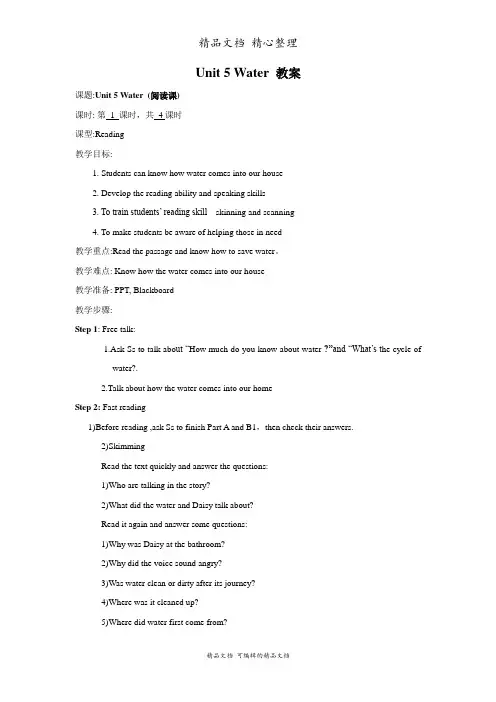
Unit 5 Water 教案课题:Unit 5 Water (阅读课)课时: 第 1 课时,共 4 课时课型:Reading教学目标:1. Students can know how water comes into our house2. Develop the reading ability and speaking skills3. To train students’ reading skill---skinning and scanning4. To make students be aware of helping those in need教学重点:Read the passage and know how to save water。
教学难点: Know how the water comes into our house教学准备: PPT, Blackboard教学步骤:Step 1: Free talk:1.Ask Ss to talk abo ut “How much do you know about water ?”and “What’s t he cycle ofwater?.2.Talk about how the water comes into our homeStep 2: Fast reading1)Before reading ,ask Ss to finish Part A and B1,then check their answers.2)SkimmingRead the text quickly and answer the questions:1)Who are talking in the story?2)What did the water and Daisy talk about?Read it again and answer some questions:1)Why was Daisy at the bathroom?2)Why did the voice sound angry?3)Was water clean or dirty after its journey?4)Where was it cleaned up?5)Where did water first come from?Step 3: while-reading.1.Learn some new words and phrases.2.Do some exercises and check their answers.3.Careful readingRead the article again,then choose the best answer.Reading comprehension.Read the text in details and finish the blank filling exercise in a sheet, then check the answers ,after that , try to design questions according to the text and ask your classmates to answer it .Step 4: Post- reading.1. D ComprehensionLook at the map of the water’s journey. Then talk about the water’s journey.Check their answer.2.Read a diary between Dora and a drop of water. Then fill in the blanks.3. D2 Ask Ss to read the article again and answer some questions.Step 5:More practice1. Use the right forms of the expressions to finish the sentences.2. Translate the Chinese sentences into English by using the important phrases in the text3. work in group to check the answers.step 6: Sum upStep7 :HomeworkStep8 The black designUnit 5 Waterbe on , turn off, waste water,a drop of , it is time for...to ...,the end of ,make me clean , pollute ... ,come out of, travel through,waste time。
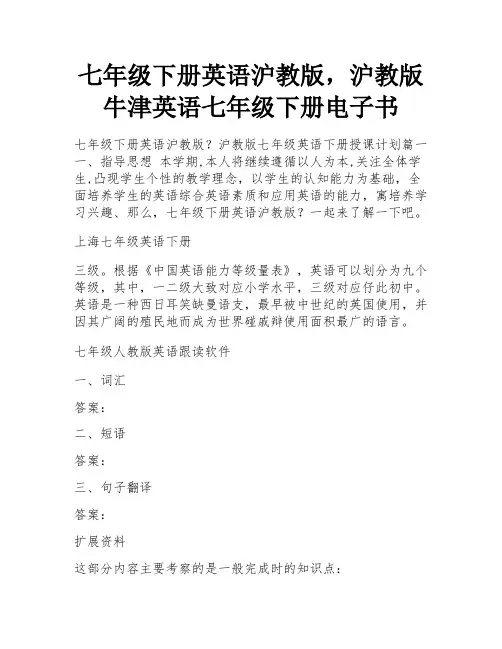
七年级下册英语沪教版,沪教版牛津英语七年级下册电子书七年级下册英语沪教版?沪教版七年级英语下册授课计划篇一一、指导思想本学期,本人将继续遵循以人为本,关注全体学生,凸现学生个性的教学理念,以学生的认知能力为基础,全面培养学生的英语综合英语素质和应用英语的能力,寓培养学习兴趣、那么,七年级下册英语沪教版?一起来了解一下吧。
上海七年级英语下册三级。
根据《中国英语能力等级量表》,英语可以划分为九个等级,其中,一二级大致对应小学水平,三级对应仔此初中。
英语是一种西日耳笑缺曼语支,最早被中世纪的英国使用,并因其广阔的殖民地而成为世界碰戚辩使用面积最广的语言。
七年级人教版英语跟读软件一、词汇答案:二、短语答案:三、句子翻译答案:扩展资料这部分内容主要考察的是一般完成时的知识点:过去式表示过去某个时间发生的动作或简单描述过去的事件,强调动作;现在完成时发生在过去,强调过去对现在的影响,强调影响。
过去清帆常与具体的时间状语连用,现在完成时通常与模糊的时间状语连用或不与时间状语连用。
"完成体"分为答雹"现在完成体"和"过去完成体"."完成体"是表示一个动作或事态已经完成的动词形式.完成体是由助动词have+主动词的-ed分词构成.如果构成完成体的助动词have采取现在时的形式,这便构成"现在完成体";构成完成体的助动词衡散have如果以过去时形式出现,便构成"过去完成体现在完成时可表示持续到现在的动作或状态,动词一般是延续性的,如live, teach, learn, work, study, know.过去时常用的非持续性动词有e, go, leave, start, die, finish, bee, get married等。
七下英语书上海教育出版社学习一门外语并不难。
学习外语就像交朋友。
朋友越来越熟。
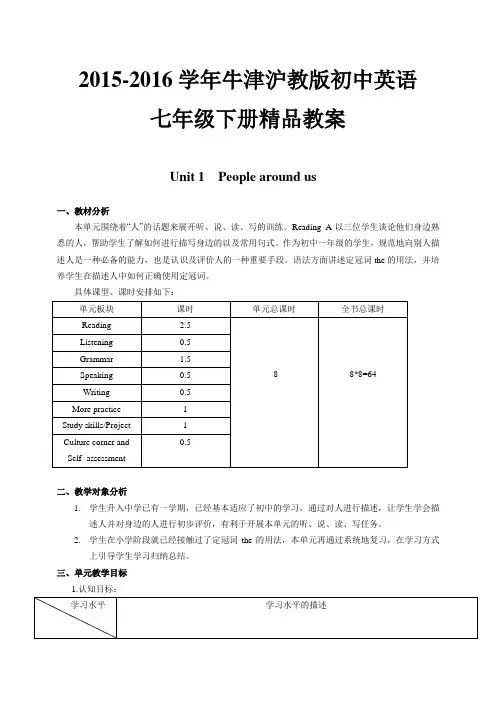
2015-2016学年牛津沪教版初中英语七年级下册精品教案Unit 1 People around us一、教材分析本单元围绕着“人”的话题来展开听、说、读、写的训练。
Reading A以三位学生谈论他们身边熟悉的人,帮助学生了解如何进行描写身边的以及常用句式。
作为初中一年级的学生,规范地向别人描述人是一种必备的能力,也是认识及评价人的一种重要手段。
语法方面讲述定冠词the的用法,并培养学生在描述人中如何正确使用定冠词。
具体课型、课时安排如下:二、教学对象分析1.学生升入中学已有一学期,已经基本适应了初中的学习,通过对人进行描述,让学生学会描述人并对身边的人进行初步评价,有利于开展本单元的听、说、读、写任务。
2.学生在小学阶段就已经接触过了定冠词the的用法,本单元再通过系统地复习,在学习方式上引导学生学习归纳总结。
三、单元教学目标1.认知目标:2. 思想情感目标:1)通过谈论“身边的人”的相关话题,帮助学生如何描述人并对身边的人作出适当的评价。
2)结合课文的内容,引导学生如何对身边的人作出评价作谨慎交友。
3. 能力发展目标:1)能够在听、说、读、写等语言综合实践活动中运用本单元的重点词汇、句型与语法。
2)在学习中提高交流和传递信息的能力,在写作中正确运用连词使文章更连贯和流畅。
3)通过指导学生在模拟交际中运用所学的知识,培养学生探究学习、合作学习、自主学习的能力。
四、单元教学重点1. 学生熟练掌握重点词语,词组及句型。
2.指导学生利用所学句型正确表达思想、进行交际活动。
3.指导学生归纳、总结定冠词the的用法,并在实践运用中熟练运用。
4. 指导学生巩固写人的基本方法。
五、单元教学难点1. 如何进行描述人。
2. 定冠词the的归纳整理及运用。
六、教学策略1. 引导学生积极主动的通过预习完成可以自己学会的部分,课堂学习完成学习的重难点,通过复习及归纳总结完善单元的学习。
2. 在教学中以旧带新,引导学生用正确的句子表达思想。
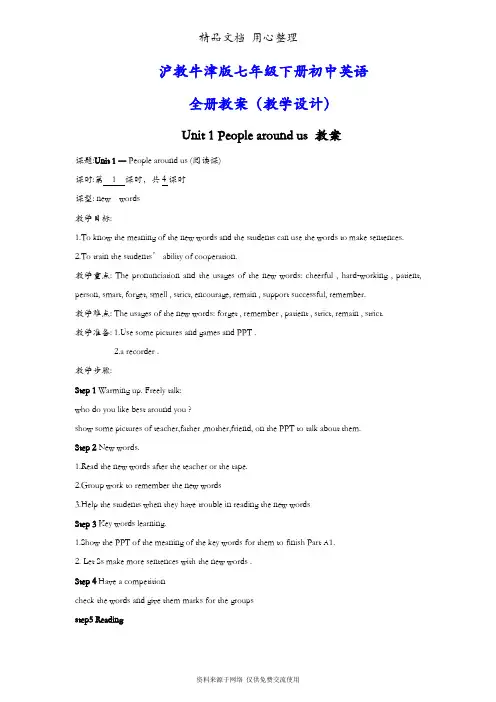
沪教牛津版七年级下册初中英语全册教案(教学设计)Unit 1 People around us 教案课题:Unit 1 --- People around us (阅读课)课时:第 1 课时,共4课时课型:new words教学目标:1.To know the meaning of the new words and the students can use the words to make sentences.2.To train the students’ ability o f cooperation.教学重点: The pronunciation and the usages of the new words: cheerful , hard-working , patient, person, smart, forget, smell , strict, encourage, remain , support successful, remember.教学难点: The usages of the new words: forget , remember , patient , strict, remain , strict.教学准备: e some pictures and games and PPT .2.a recorder .教学步骤:Step 1 Warming up. Freely talk:who do you like best around you ?show some pictures of teacher,father ,mother,friend, on the PPT to talk about them.Step 2 New words.1.Read the new words after the teacher or the tape.2.Group work to remember the new words3.Help the students when they have trouble in reading the new wordsStep 3 Key words learning.1.Show the PPT of the meaning of the key words for them to finish Part A1.2. Let Ss make more sentences with the new words .Step 4 Have a competitioncheck the words and give them marks for the groupsstep5 ReadingBefore reading : 1.Ask Ss to look at the pictures and the titles of the three articles on page 3.2.Check their answers.While reading : 1.Read the article quickly, and then finish Part D1.2. Check their answers.Post reading: 1.Ask Ss to finish Part C1 and C2.2. Check their answers.Step 6 Reciting the article1.Play the tape for them to listen and repeat.2.Show PPT for them to retell the article.ExercisesTo consulate the usages of the new wordsstep 7 SummaryGive them a piece of paper to write the words.Step 8 Homework1.Dictation2.correct the mistakesStep9 The blackboard designUnit 1 People around us1. be cheerful快乐2.as well 也3.take care of 照顾4.tell jokes 讲笑话5.make sb laugh 使某人发笑6.be good at 擅长于…7.be strict in sth 对某事严格要求be strict with sb对某人严格要求课题:Unit 1 People around us (听说课)课时:第2课时,共 4 课时课型:Listening & Speaking教学目标:1.Learn how to use the new words or phrases to describe a person2. improve their listening and speaking skills教学重点: To catch the missing words when listening教学难点: Learn to take note quickly when listening教学准备: Group work. Self—study教学步骤:Step 1: Prepare for the listening and speakingReview some words and phrases which can be used to describe a person Step 2: Do the listening1.Play the listening materials , stop when necessary2.Check the answersStep3.SpeakingGive a sample dialogue to students and ask them to imitate itStep 4:Make notes about the listening.1.Tell them to find the key words.2.Write down the key words you get in the listening part.Step5 Speaking1.学习双元音/iə/、/eə/、/uə/1)Read after the teacher or the tape.2)Read by themselves.2.Listen to the tape and finish A1 then check their answers.3.Learn A2. Ask Ss to read these sentences. Pay attention to the letters in red.4.Speaking upWork in groups to discuss the people they like .S1: Who do you like?S2: I like …S1: What does/did he/she look like?…Step6:Sum upStep7HomeworkStep8 The blackboard designUnit 1 People around us1.描写人的外貌的词2. 双元音/iə/、/eə/、/uə/课题:Unit 1 People around us(语法及运用课)课时:第3时,共 4 课时课型:Grammar教学目标:1.to grasp the usage of the definite word the and the preposition with2. to raise the students’ ability to sum up some language rules教学重点: Know when should use the in front of a noun and when we should not use it and the usage of the with phrases to describe a person教学难点: When we should not use the in front of a noun.教学准备:PPT, Blackboard教学步骤:Step1:Free talkTalk about the noun with an, a and the .Step2: WritingBefore writing: Give Ss the title of the article to talk about.1.Who are you going to write about?2.Think about the following ideas.1)a family member2)a good friend3)a teacher or a great personWhile writing:1.Write a short article about this person.Show some PPT to help them to write the article.2.介绍一些描述人常用的词汇.3. Ask Ss to re ad “My dad”as an example.Step3:More practiceAsk Ss to re ad the article about Mother’s Day quickly.Then answer the questions.1.When is Mother’s Day?2.What do people like to do this day?3.What do the author advise people to do on this day?Step4 Study skills1.Learn line graphs and bar charts to show the change in numbers.2.Fill in the blanks.3.Check their answers.Step 4:Culture corner1.Introduce middle names for Ss.2.Write some famous people’s middle names.Step5:Sum up1.Go over the rules of theStep6: HomeworkStep7 The blackboard design1.冠词“a\an”的用法。
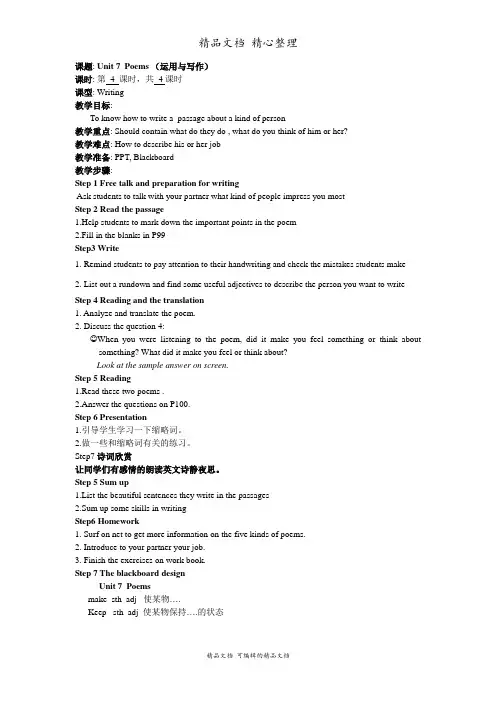
课题: Unit 7 Poems (运用与写作)课时: 第 4 课时,共 4 课时课型: Writing教学目标:To know how to write a passage about a kind of person教学重点: Should contain what do they do , what do you think of him or her?教学难点: How to describe his or her job教学准备: PPT, Blackboard教学步骤:Step 1 Free talk and preparation for writingAsk students to talk with your partner what kind of people impress you mostStep 2 Read the passage1.Help students to mark down the important points in the poem2.Fill in the blanks in P99Step3 Write1. Remind students to pay attention to their handwriting and check the mistakes students make2. List out a rundown and find some useful adjectives to describe the person you want to write Step 4 Reading and the translation1. Analyze and translate the poem.2. Discuss the question 4:☺When you were listening to the poem, did it make you feel something or think about something? What did it make you feel or think about?Look at the sample answer on screen.Step 5 Reading1.Read these two poems .2.Answer the questions on P100.Step 6 Presentation1.引导学生学习一下缩略词。
Unit 3 Our animal friends 教案课题:Unit 3 Our animal friends课型:Reading课时:第 1 课时,共 4 课时教学目标1.Students can master how to pronounce the new words and master the meanings of the words .2.Let students know more about dogs.3.To master some usages of some useful expressions and develop an ability of how to get a further understanding of the text.4.Develop the reading ability and speaking skills教学重点: Know the structure and contents of the main article教学难点: Imagine the use of dogs. Find out more helpful animals in our daily life.教学准备: PPT, Blackboard教学步骤:Step I: Pre-reading1.Show a picture of a dog to arouse the interest and lead them to get into the topic of this unit.a)Do you like dogs?b)Dogs are our friends.They help us a lot.2.Talk about the kinds of dogs in groups.3.Finish Exercise A on Page 30.A.Match the kinds of dogs in the box with the pictures below.4.Talk about the following questions and help the students answer them.a)What does a police dog do?b)What does a rescue dog do?c)What does a guide dog do?Step II: While-reading Procedure1.Look at the photos and the title of the story on page 31. Then answer the questions below.a)What do you think the word “eyes” means in the story?b)What is the story probably about?2.Read the text quickly and let the students get the general idea of the text.3.Read the first three paragraphs and answer the questions.a)Did the receptionist want to allow Charlie to stay in the hotel? Why or why not?b)What is Charlie?c)What did the receptionist do then?4.Read the last two paragraphs and plete the chart.5.Learn some new words and help them understand main words.Step III:Discussion1.Students work in groups and discuss the following question.How do dogs save people ?2.Encourage the students to given their possible answers.Step IV: Reading prehension.Read the text in details and finish the blank filling exercise in a sheet, then check the answers. Step V: Sum upStep VI:Homework1.Read the text fluently2 write a passage to introduce your favorite animal.Step VII:The blackboard designUnit3 Our animal friendshelp n.&v.帮助——helpful adj. 有用的;有帮助的appear v.出现——disappear v. 消失act v. 扮演——actor n. (男)演员。
牛津上海版七年级英语下册教案:XXX 教学目标XXX:Language learning objectives:By the end of the lesson the students will be able to pronounce。
know the meanings of the keywords in the context of“The happy farmer and his wife”By the end of the lesson the students will be able to get the main XXX:1.By the end of the lesson the students will have XXX.2.By the end of the lesson the students will have practiced reading skills of skimming。
predictingand scanning.三.Character training objectives:1.By the end of the lesson the students will have learned that a man who is XXX.)2学情阐发学情分析:本次执教的七年级(二)班,英语根蒂根基比力单薄。
班级中有少量同砚思惟活泼,可是因为英语程度和表达本领的限定,呈现“愿说却说欠好”的征象。
更有局部同砚教室上缺少自傲,形成了“想说怕说欠好而不说”的征象。
因而,教师需求在教室上搭建平台,匡助学生勉励学生用英语表达。
以是我设想林林总总风趣又有用的教学举动(看动画片,游戏,脚色朗诵等)但愿能变更学生的主动性,进步自自傲心,同时匡助他们从童话故事中获得人生的哲理。
3重点难点本课作为阅读课,采用了“PWP”阅读教学模式,以读促说。
主要教学重点是词汇教学。
考虑到本课单词比较多,在对词汇进行处理的过程中,我不集中一次教授,而是随着课堂教学的进展,分批处理,在不同环节中采用灵活多样的教学方法引入并且教授。
Unit 1Writing a tourist guide一、单元分析( Unit Analysis)(一)元地位(Unit Position)1本中出了“If you go⋯, you will ⋯”的条件状从句。
个句式在7A Module 3The natural elements Unit 3 Sea water and rain water中已出。
如:If there is norain, there will be no water to drink.等。
作功能言,教有必要在堂教学中加以一定的机械性。
2I’d suggest they go ⋯的用法也有多出,并且首次出,文中主要合上海的各个景点。
教可以根据所在区域多个景,学生行操。
(二)元目(Unit Target )1 运用情would 来表达“建”。
如 : I’d suggest they go to NanjingRoad.2 运用 if 句式表达条件。
如 : If you go to Pudong New District in the east of Shanghai,you will see the Nanpu Bridge.3 用有名来表示地点。
如: Yu Garden4 运用 there is/ are ⋯, It is ⋯句式来表示事。
(三)元重点(Unit Points )1关:1)地方名称: Sheshan State Resort, Nanjing Road, Yu Garden, Shanghai Museum,People ’s Square, Nanpu Bridge, Oriental Pearl TV Tower, Pudong New District,Water World, Shanghai Grand Theatre, the Municipal Hall。
2)固定短: be famous for, be known as, in the world, in the east of, do some shopping 。
牛津英语七年级下教案M1U1(7B)Period 1Teaching objectives1.To review direction words and phrases (in dialogues)2.To learn new words and a phrase:creek, oriental, pearl, botanical, technology, guide, pigeon, reason, sightseeing, take part in (by reading pictures, E-E explanation and multiple choices)3. to introduce interesting places in Shanghai (in dialogues)Pre-task1. Make suggestions on traveling in ShanghaiWhile-task1. Read pictures to learn new wordsthe Suzhou Creek; the Bund, Shanghai Grand Theatre; Shanghai Botanical Gardens; Oriental Pearl TV Tower; Century Park; Shanghai Science and Technology Museum;2. listen and say1). listen and answerKitty and her classmates have just been to Shanghai. They have decided to take part in a competition to see who knows Shanghai best.take part in :*Which places do students suggest to travel in Shanghai?3. Read sentence by sentence after the audio4. Read together with the audio5. Fill in blanks to tell the reasons in WRITE on page 26. Review direction expressions1) review directions2) ask and answer in pairs to review direction3) learn new words : sightseeing7. Make dialogues on page 3 in pairs with the map aboveHomework:Oral : to give your suggestion on traveling in Shanghai to your friendWritten: workbook page 1 ;to copy phrases1.take part in a competition参加一个竞赛2.design a travel guide设计一个旅行指南3.Make some suggestions给出一些建议4.eat different local snacks 吃不同种类的地方美食5.In large department stores在大型百货公司6.Shanghai Grand Theatre上海大剧院7.Oriental Pearl TV Tower 东方明珠电视塔8.Shanghai Science and Technology Museum上海科技馆9.Shanghai Wild Animal Park上海野生动物园10.Suzhou Creek苏州河11. Where can tourists go for sightseeing in Shanghai?在上海,游客可以去哪里观光?Comments: it is hard for ss to read and spell out some names of placesM1U1(7B)Period 2Teaching objectives1.To review direction words and phrases (in dialogues)2.To learn new words and a phrase:creek, oriental, pearl, botanical, technology, guide, pigeon, reason, sightseeing, take part in (by reading pictures, E-E explanation and multiple choices)3. to introduce interesting places in Shanghai (in dialogues)Pre-task1. listen and reviewWhile-task1. Learn new phrases in situation and consolidate by making examplesbe famous for; be known as2. learn new words and phrases by reading picturesnight view; shopping paradise; district; Maglev; state; resort; observatory3. learn new words in E-E explanationget on well with4. read silently and answer questions for the first paragraph;5. answer questions to complete the second paragraph;6. read paragraph 3 silently and do True or False; retell according True or False7. read paragraph 4 silently and answer questions; explainHomeworkOral: recite paragraph 1+2/3/4; read the leftWritten: workbook page 4,5; copy words and phrases:词汇:1. therefore 因此 adv.词组:2. an observatory 一个天文台3. get on with 进展4. be famous for night views以夜景而著名5. be known as 被认为…;誉为…6. a shopping paradise 购物天堂7. one of the largest cities 最大的城市之一8. a huge open area with green grass一片巨大的开放的绿地9. Pudong New District 浦东新区10. go there for sightseeing and fun 去那里观光游乐句子:11. How are you getting on with your travel guide? 你们的旅行指南进展怎样了?12. It’s convenient to travel between Pudong and Puxi. 在浦东和浦西之间通行很方便。
课题: Unit 3 Our animal friends课时: 第 4 课时,共 4 课时课型: Writing教学目标:1.The students can talk about dogs laws.2.Students can write some sentences on helpful animals .3.Students should be ready to help others..教学重点: Talk about dogs laws.教学难点: Write out the sentences about helpful animals..教学准备: PPT, Blackboard教学步骤:Step I: Before writing1.Read the culture corner about the dog laws in the UK.2.Answer the two questionsa.What must dogs wear in public places in the UK? Why?b.What kind of dogs needn’tt follow this law?c.Talk about the dog laws in our country.Step II:.Writing.a.Show a picture of animals on a farm.b.Choose one of the animals and talk about how it helps people.c.Write an article about it. Use the following words and the sentences to help you. Step III:Discussiona.Show a picture of animals.b.What animal do you like best?c.What is special about this animal?d.Why do you like this animal?e.Is this animal helpful to people?Step IV:Show time1.Walk around to find the better work to show around.2.Correct the work and remend the better one to learn from.Step V: Sum up1.List the beautiful sentences they write in the passages2.Sum up some skills in writingStep VI: HomeworkRewrite the article in the exercise book. Step VII:. The blackboard designUnit 3 Our animal friendsDog laws 狗的法律Helpful animals 有用的动物。
辛安泉中学七年级英语(教)学案
小学二(2)班班规
一、安全方面
1、每天课间不能追逐打闹。
2、中午和下午放学要结伴回家。
3、公路上走路要沿右边走,过马路要注意交通安全。
4、不能在上学路上玩耍、逗留。
二、学习方面
1、每天到校后,不允许在走廊玩耍打闹,要进教室读书。
2、每节课铃声一响,要快速坐好,安静地等老师来上课。
3、课堂上不做小动作,不与同桌说悄悄话,认真思考,积极回答问题。
4、养成学前预习、学后复习的好习惯。
每天按时完成作业,保证字迹工整,卷面整洁。
5、考试时做到认真审题,不交头接耳,不抄袭,独立完成答卷。
三、升旗排队和两操方面
1、升旗时,要快速出教室排好队,做到快、静、齐,安静整齐地排队走出课室门,班长负责监督。
2、上午第二节后,快速坐好,按要求做好眼保健操。
3、下午预备铃声一响,在座位上做眼保健操。
四、卫生方面
1、每组值日生早晨7:35到校做值日。
2、要求各负其责,打扫要迅速彻底,打扫完毕劳动工具要摆放整齐。
3、卫生监督员(剑锋,锶妍,炜薪)要按时到岗,除负责自己的值日工作外,还要做好记录。
五、一日常规
1、每天学生到齐后,班长要检查红领巾。
2、劳动委员组织检查卫生。
3、每天负责领读的学生要督促学生学习。
4、上课前需唱一首歌,由文娱委员负责。
5、做好两操。
6、放学后,先做作业,然后帮助家长至少做一件家务事。
7、如果有人违反班规,要到老师处说明原因。
班训:
坐如钟站如松快如风静无声
班规:
课堂听讲坐如钟,精神集中认真听;
排队升旗站如松,做操到位展雄风;
做事迅速快如风,样样事情记得清;
自习课上静无声,踏实学习不放松;个人努力进步快,团结向上集体荣;我为领巾添光彩,标兵集体记我功。
扣分标准
注:每人基本分60分起,学期末核算总分,作为学期评先依据。